If imagining a trip to Las Vegas, Nevada, brings to mind bottomless drinks, sky-high hotels, sparkling casinos, kitschy wedding chapels and miles of clubs, you’re not alone. But Las Vegas is also a gateway to the desert Southwest, a part of America that includes vast, spectacular landscapes, colorful rock formations, unique flora and fauna, canyons and mountaintops.
Some outdoor adventurers kick off their Southwestern trips in Las Vegas for a night or two before chasing a “nature cleanse” in one of the many surrounding national parks, like Death Valley, Zion or Grand Canyon. Others skip the casinos altogether and use Las Vegas as a staging point for their journey.
If a visit to Vegas—and the surrounding natural playgrounds—sounds like a dream come true, this guide will cover:
- Why Visit the Desert Southwest via Las Vegas?
- The Top Sites and Things to Do Around Las Vegas
- The Top Outdoor Activities Around Las Vegas
- How to Plan Your Trip
Why Visit the Desert Southwest via Las Vegas?
Although Las Vegas may be known for its exuberant parties, it’s also a gateway city to the desert Southwest and, by extension, the Colorado Plateau, two spectacular regions that REI Adventures Program Manager Andrew Kronen says many Americans take for granted.
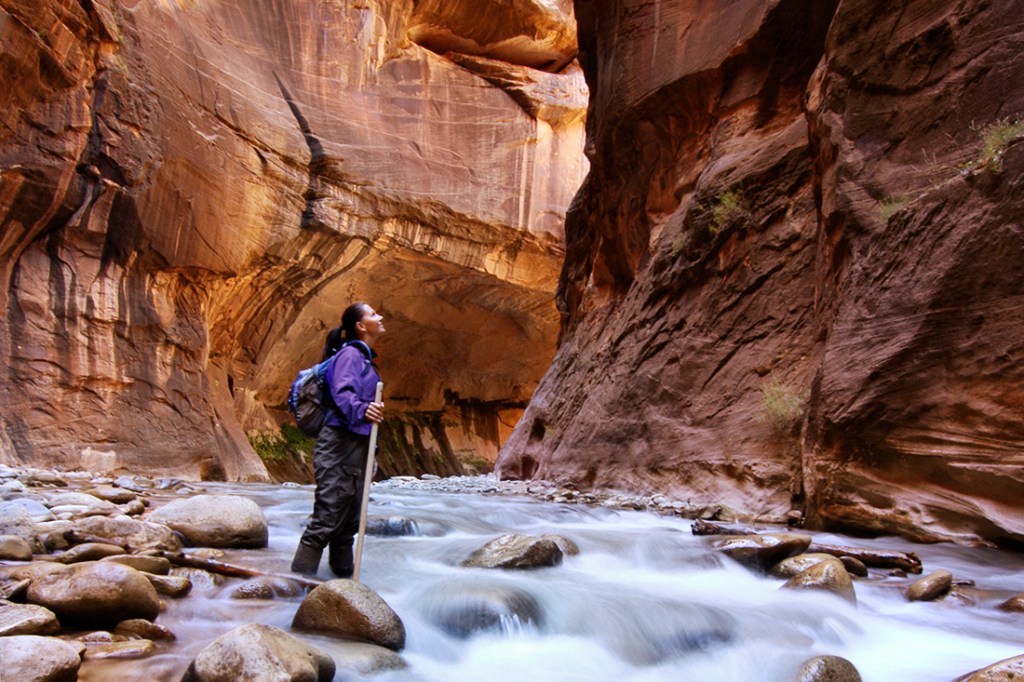
A woman enjoys a moment of reflection while hiking through The Narrows in Zion National Park.
In fact, the Las Vegas Review-Journal recently reported that while the Nevada Division of Tourism is funded largely by the revenue generated from hotel room taxes in Las Vegas, most of its promotional budget is now aimed at teaching people about the more rural parts of this often-ignored part of America.
“You won’t find landscapes like this anywhere else in the world, and if you live in the U.S., this is in your own backyard,” Kronen says.
Las Vegas’ location makes it a great jumping-off point for outdoor excursions: You can visit many national parks and federal lands in six hours (or fewer) of driving from the McCarran International Airport. If you want to combine the urban landscape with time spent in nature, you can devote a day or two to exploring the Las Vegas Strip before renting a car and leaving the city.
The Top Sites and Things to Do Around Las Vegas
Starting your trip from Las Vegas means you’ll have great access to some of the most beautiful national parks and public lands in the U.S., says Kronen. Popular outdoor trips from Las Vegas include:
Red Rock Canyon National Conservation Area
Just 20 minutes (without traffic) from McCarran International Airport, you’ll find Red Rock Canyon, easily viewed from a one-way, 13-mile scenic drive through colorful rock formations. Hiking is popular on this BLM property, with options ranging from the Calico Tanks hike (2.2 miles, moderate) to Turtlehead Peak (4.6 miles, strenuous). Additionally, rock climbing is very popular in this area, with many established routes for all skill levels. Keep your eyes peeled for wildlife in the park, including ringtails, kit foxes and bighorn sheep.
Red Rock Canyon is open year-round for visitors and makes for a solid day trip—or overnight camp mission—from the big city.
Valley of Fire State Park
You might also consider a day trip to the Valley of Fire State Park, which is only an hour from the Las Vegas city center. This park offers 40,000 acres of bright red sandstone outcrops nestled in limestone, which adds a striped effect to all of the geological formations you’ll see as you hike. The Valley of Fire State Park is open year-round.
Death Valley National Park
Death Valley is the largest national park in the lower 48. It’s a land of extremes: It contains the lowest point in America, Badwater Basin, a vast landscape of salt flats at 282 feet below sea level; as well as Telescope Peak, which reaches just over 11,000 feet above sea level. The hottest temperature ever recorded on Earth was 134 degrees Fahrenheit, at Furnace Creek in Death Valley in 1913. The past two Julys in Death Valley have set the record for hottest monthly temperature in the world.
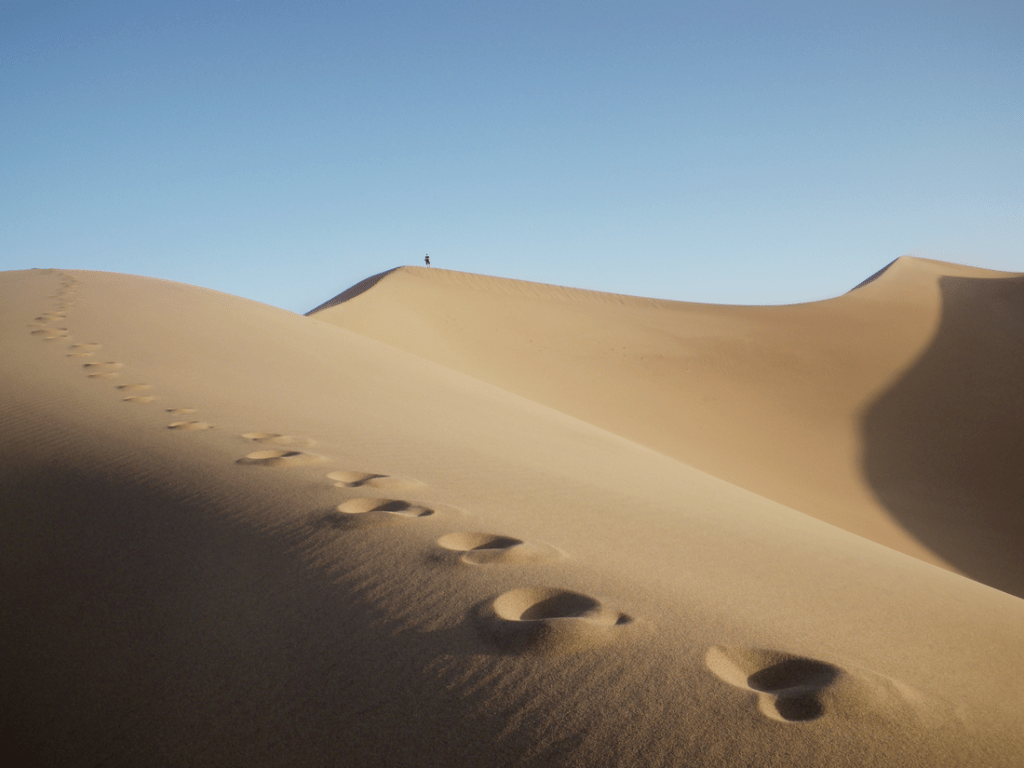
A hiker peaks a sand dune in Death Valley National Park.
“The ecosystem and geology [in Death Valley] are diverse,” says Kronen. “You get mountains, rocks, huge sand dunes, vast salt flats, peaks that tower up above you at 10,000 feet and so much more. It’s stark and it all makes for a very spectacular picture.”
Death Valley is also popular for its spring wildflower bloom. “Every six to seven years, you get a super bloom,” Kronen says. “That occurs when there’s the right rainfall and spring temperatures are warm enough. It’s stunning.”
Death Valley is a year-round park, although winter visitors may see a bit of snow and summer visitors need to be equipped for extreme heat. Gas stations and amenities are few and far between. Depending on your destination within this large park, the drive is approximately 2.5 to four hours from McCarran International Airport.
Zion National Park
Zion is a smaller park in comparison to Death Valley. But, Kronen says, “this park is a jewel.” Zion is known for its steep-walled “heart,” Zion Canyon, which is threaded by the sparkling Virgin River. It’s also known for its scenic driving route. Among the multicolored rocks and grottoes of the canyon are several iconic hikes, including vertigo-inducing Angel’s Landing with its chain handrail and sheer drop-offs, and the riverbed hike known as The Narrows, which takes you wading knee-deep through the Virgin River (be sure to check the weather report as flash floods can be sudden and fatal).
“Even when I think about all the hikes I’ve done around the world, I think back on these hikes [in Zion] as being unusual and dramatic,” Kronen says. “They showcase the landscapes in a way that a lot of other parks don’t do.”
Zion is another year-round park, although the cold temperatures of the winter months ensure that most travelers visit in the spring, summer and fall. During the summer months, temperatures can top 100 degrees. Zion is an approximately three-hour drive from McCarran International Airport without traffic.
Note: In peak season, arrive early or late in the day; otherwise, there may be long lines of cars trying to get into the park, so plan to park in Springdale and ride the free shuttle.
Read more:
Zion National Park Visitor Guide
Bryce Canyon National Park
Often tackled alongside Zion because of their close proximity, Bryce Canyon is especially well known for its hoodoos, or fantastical columns of eroded rock. Bryce sits along a high plateau at the top of the Grand Staircase, a vast swath of cliffs and step-like terraces; parts of the park reach elevations of up to 9,000 feet above sea level. (Some visitors may feel the physical effects of higher elevation; see the CDC’s recommendations for sleeping at altitudes above 8,000 feet.)
Visitors often come to Bryce Canyon to explore the Fairyland Loop Trail and the Queens Garden Trail. “The highlight of this park, if you go, is to see the Bryce Amphitheater with its sandstone pinnacles,” says Kronen. “Also, hike among the hoodoos and make a point to be at the rim for a sunrise or sunset. These are some of the most dramatic views in the U.S.”
Bryce Canyon is about four hours from Las Vegas and, like Zion, most people choose to visit in the fall, spring or summer months. Because of the elevation, winter in Bryce Canyon can be brutally cold and snowy.
Read more:
How to Explore Bryce Canyon National Park
The Grand Staircase-Escalante National Monument
Kronen says the varied landscapes of this national monument are not to be missed: “This park incorporates the geology of Zion, plus canyons and cottonwood-lined rivers, and it’s much less known, so it’s not as crowded.”
This part of Utah was only set aside as a national monument in 1996, so researchers and explorers are still getting to know its landscapes. The Grand Staircase-Escalante National Monument offers many popular hikes, including the relatively easy but picturesque Escalante River hike, and the difficult Coyote Gulch canyon hike.
The Monument is located in south-central Utah, roughly a four-hour drive from Las Vegas. Plan to visit the Grand Staircase-Escalante National Monument during the spring, summer or fall.
Grand Canyon National Park
The realm of Vishnu schist and Zoroaster granite, the Grand Canyon is an immense watershed that drains the entirety of the Colorado Plateau. The canyon itself is roughly 277 river miles long, 18 miles wide and one mile deep (depending on location). The canyon’s more remote North Rim is higher than the South Rim by a couple thousand feet, which makes it difficult to access in the winter due to deep snow. In fact, park services on this side of the rim are closed during the winter months.
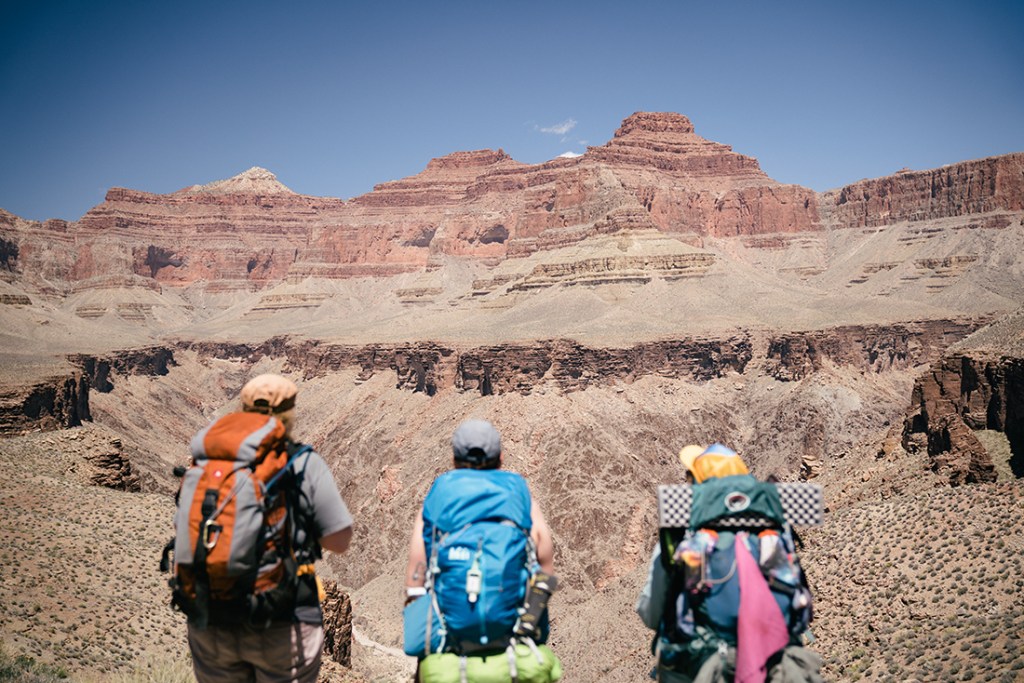
Backpackers take in the topographic contours of Grand Canyon National Park.
“This is definitely a spring, summer and fall destination,” says Kronen. The park’s North Rim opens to visitors on May 15 every year; lodging and camping is limited, so plan ahead.”
The 1928 Grand Canyon Lodge North Rim, built of stone and timbers in traditional national park style, along with its historic log cabins, is the only accommodation on the North Rim. Be sure to book ahead, eat in the grand dining hall and enjoy sunset from the chairs on the rim terrace. Some visitors choose to camp and use the lodge as a trailhead for popular hikes such as the North Kaibab Trail.
Traveling to the North Rim Lodge on the edge of the Grand Canyon requires about six hours of driving from McCarran International Airport in Las Vegas.
Read more:
Grand Canyon National Park Visitor Guide
Grand Canyon Backpacking List
Capitol Reef National Park
Located about six hours from Las Vegas by car and about 2.5 hours past Bryce Canyon, this park is on the outer limits of outdoor destinations accessible via Las Vegas—but it’s well worth a visit, according to Kronen.
“This park is a wrinkle in the Earth’s crust,” says Kronen. “The Waterpocket Fold spans the length of the park. You can find great hiking, too; it’s a massive jumble of multicolored rocks with trails throughout, allowing you to get out there and have a crash course in some of the region’s most interesting and fascinating geology.”
There are 15 day-hiking trails in this park, ranging from the relatively easy Capitol Gorge hike (just one mile each way) to the strenuous Golden Throne hike, which offers views of the Capitol Gorge from on high. Consider visiting Capitol Reef in the summer, spring or fall months, as winter is quite cold and many of the region’s visitor centers are closed.
The Top Outdoor Activities Around Las Vegas
1. Cycling (Mountain Bike & Road)
If you enjoy mountain biking and road cycling through picturesque landscapes, each of the above parks offer different options. The Red Rock Bike Trail in Red Rock Canyon includes Tunnel Climb and a trip across layered sandstone in the Kodachrome Basin.
On the Kolob Canyons Road in Zion National Park, you can travel below cliffs and through valleys.
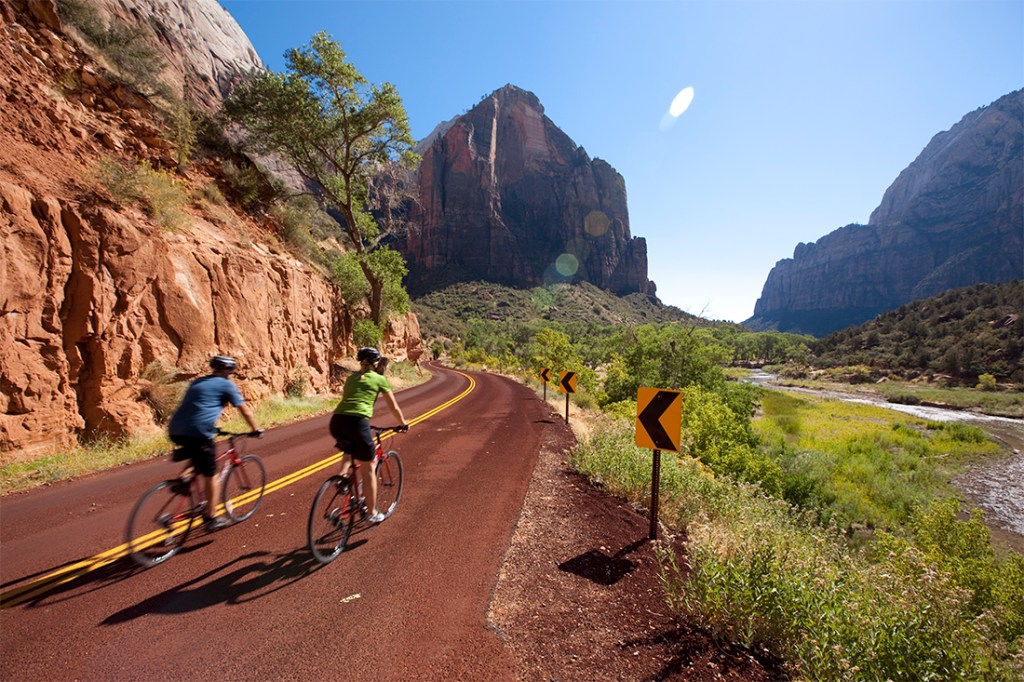
2. Hiking and Backpacking
The wildly varied landscapes of the desert Southwest make for epic hiking trips, including wanders through water on The Narrows hike in Zion National Park and the Fairyland Loop Trail in Bryce Canyon, among many other hike options. Hiking in the desert Southwest means being prepared for extreme heat and dusty landscapes, as well as iconic canyons and beautiful rock formations.
3. Climbing
The desert Southwest offers some of the best outdoor rock climbing in the United States. The Red Rock Canyon National Conservation Area, a short drive from Las Vegas, has myriad options for climbers of all skill levels. You can also tackle the limestone caves at Mount Charleston if you’re craving a challenge, or head to the Calico Basin for a day trip from the Vegas strip.
4. River Rafting
The Southwest’s rollicking rivers offer many opportunities to get your adrenaline pumping during a river rafting trip. Take advantage of overnight trips or single-day itineraries along the Colorado River. And If you’ve got weeks to spare, a multiday rafting trip through the Grand Canyon offers some of the most superlative boating in North America. Permits required.
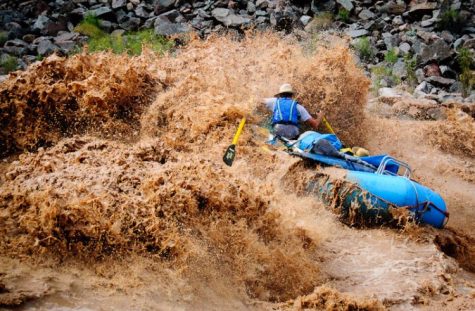
A rafter pushes through Hermit Rapid in Grand Canyon National Park at high water. (Photo Credit: Moenkopi Riverworks)
5. Kayaking
Yes, you’re headed to the desert, but you’ll still be able to find quite a few solid paddling areas. Only a short drive from Las Vegas, you can explore the coves and lagoons of Lake Mead. Also nearby, the popular Black Canyon section of the Colorado River features flat, moving water, hot springs and a grandiose sense of scale and adventure. Further afield, Lake Powell offers flatwater kayaking options, swimming and the opportunity to paddle amongst red rock canyons.
Note: Most paddling areas require a permit, so be sure to do your research before getting to the put in.
How to Plan Your Trip
When should I visit?
Summer is peak season in the Southwest, and this can mean massive crowds and long lines. Temperatures can also hover around 100 degrees (or higher) in many of the parks. Thus, to avoid the crowds and the snow but chase down moderate temperatures, Kronen recommends heading out in the spring and fall months.
“Fall, in particular, is great at Zion and Bryce because you get the cottonwood and aspen trees turning gold, which adds another dramatic punctuation point to these landscapes,” he explains.
What to pack?
If you’re planning to hit the town on the Vegas strip, pack a dress or collared shirt and a decent pair of pants and shoes, just in case the establishment you choose has a dress code. For outdoor activities beyond the city, Kronen recommends packing layers. “When you’re in the desert, you’re dealing with temperature extremes,” he says. “It’s usual for temperatures to vary from 80 degrees during the day to 30 degrees at night, especially in the spring and fall.” Thus, Kronen favors bringing lots of layers, including a warm jacket.
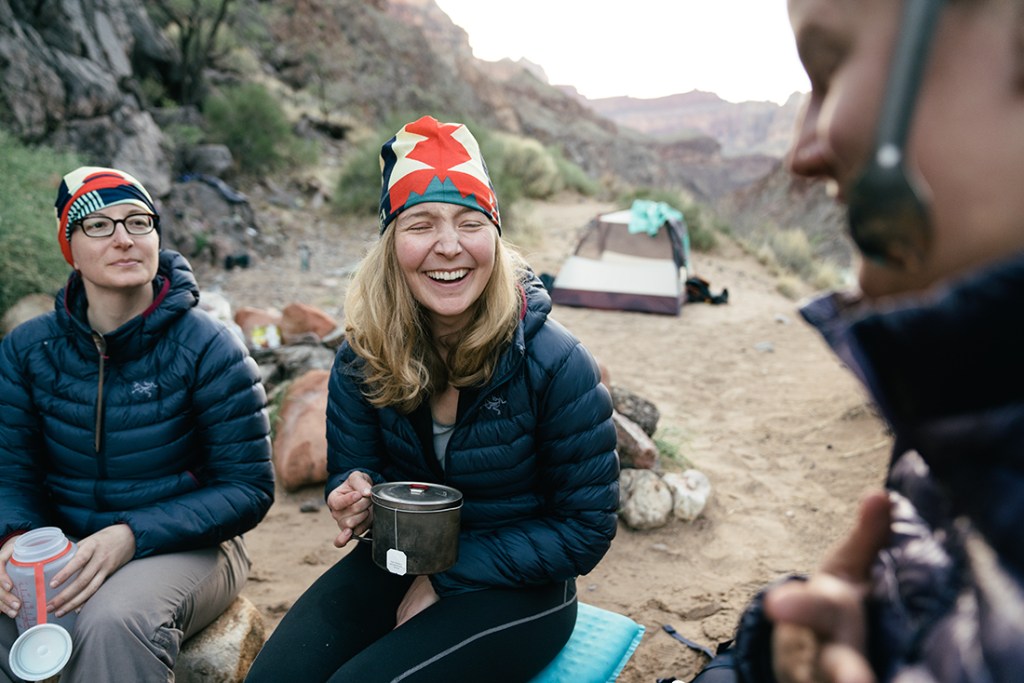
The desert is a land of extreme temps, so if camping, be sure to pack for the heat—and the cold.
The sun in the desert can also be strong, so bring sunscreen and consider wearing long pants and long-sleeve shirts for sun protection. A hat with a wide brim can also help protect your face and neck from the sun.
If you plan to do any amphibious canyon hiking in places like the Narrows in Zion National Park, where you’ll be wading through knee-deep water, you’ll want to wear shoes you don’t mind getting wet. Some people wear old tennis shoes, says Kronen, while others opt for water shoes. “Open-toed shoes are not what you want to be wearing, though,” says Kronen.
Transportation
The Las Vegas McCarran International Airport offers 500 flights per day to and from more than 150 cities around the globe, according to the Las Vegas Sun report on Federal Aviation Administration data. Thus, you’ll likely be able to find a flight to Las Vegas from most major international and U.S. cities.
Once you’ve arrived in Nevada, most visitors to Las Vegas opt to rent a car if they plan to adventure outside of the city or even off of the Strip. While the Strip may look compact, the blocks are long and you should be aware that you’ll spend a lot of time walking within the city’s most populated areas. Taxis and ride shares are available.
If you’re planning to escape city limits immediately, depending on the time of your flight, you can usually make it out to one of the above destinations on the same day, before nightfall. For those who want to spend the night before setting off on an adventure, Kronen recommends staying in Henderson, Nevada, (about 16 miles southeast of Vegas) for a night, to avoid the higher costs of staying on the Strip.
If you don’t want to rent a car, “there are shuttles from Vegas to Zion,” Kronen says. “They take you to Springdale, at the southern entrance. And in Zion, you’ll need to take the shuttle into the park anyway.”
Accommodations
In Las Vegas, most people stay in hotels on the Strip, which range from low-end to high-end.
The Encore at Wynn Las Vegas, for example, boasts pools with decadent chairs and cabanas, gilt tile work, royal purple carpeting, a massive casino and several nightclubs.
The Mandarin Oriental has multiple swimming pools, a tea lounge, Chinese art and 400 luxurious rooms.
The MGM Grand is visible from far away because of its neon signage. Inside, you’ll find five swimming pools, plus a lion statue guarding the entrance and the famous Hakkasan nightclub.
The Bellagio is best known for its dancing fountains.
Caesars Palace is covered in Roman-style decor.
The Venetian gives you a taste of Venice, Italy, including gondoliers paddling down canals.
All of these hotels will cost you a pretty penny and there are, of course, other budget hotel options available in the area, depending on your preferences.
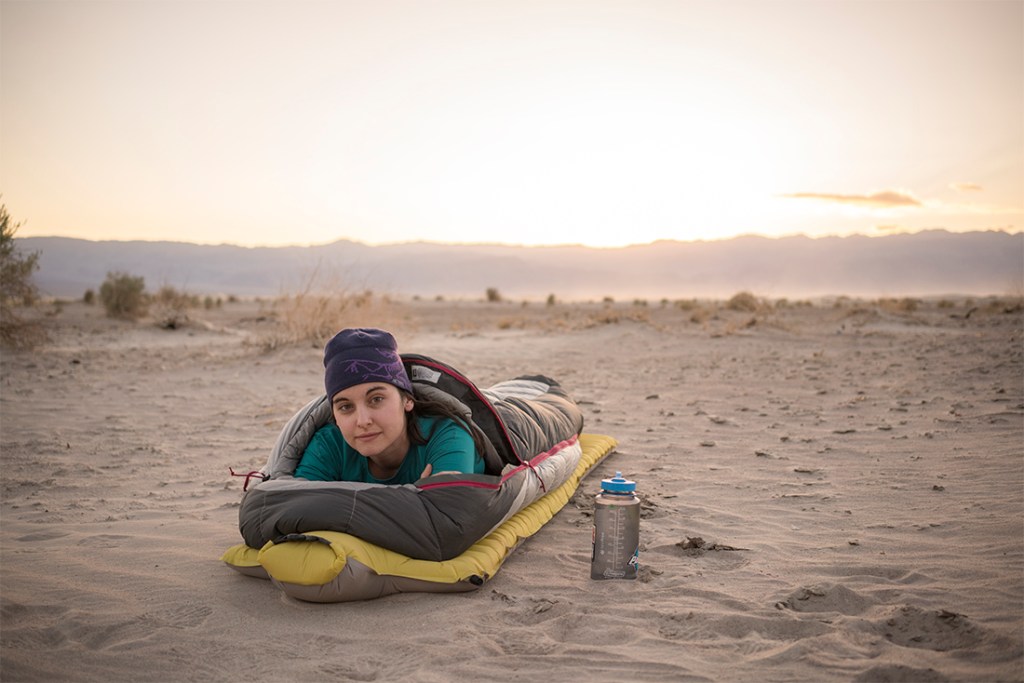
Once you’re outside of Las Vegas, you can stay in a hotel, lodge, Airbnb, cabin or a tent in the desert. Many people choose to camp during the summer, spring and fall months. (If you plan to backcountry camp, make sure you have a permit secured before you arrive.) Some parks also offer “glamping” options, like covered-wagon cabins.
“You’ll want to stay in a hotel or lodge in the winter months, though,” Kronen says.
Phone Reception
Be aware that you may lose cell reception while driving in this region, especially in places like the Grand Staircase-Escalante National Monument, which is relatively isolated. If you rely on cell service for GPS capabilities, plan to bring a paper map along with you or download directions ahead of time.
